There’s something special about colorful birds. In this post, you’ll learn about 26 of the most colorful birds in the world – with tons of facts and photos. I don’t know about you, but when I catch a glimpse of something flashy fluttering by, I can’t help but get excited.
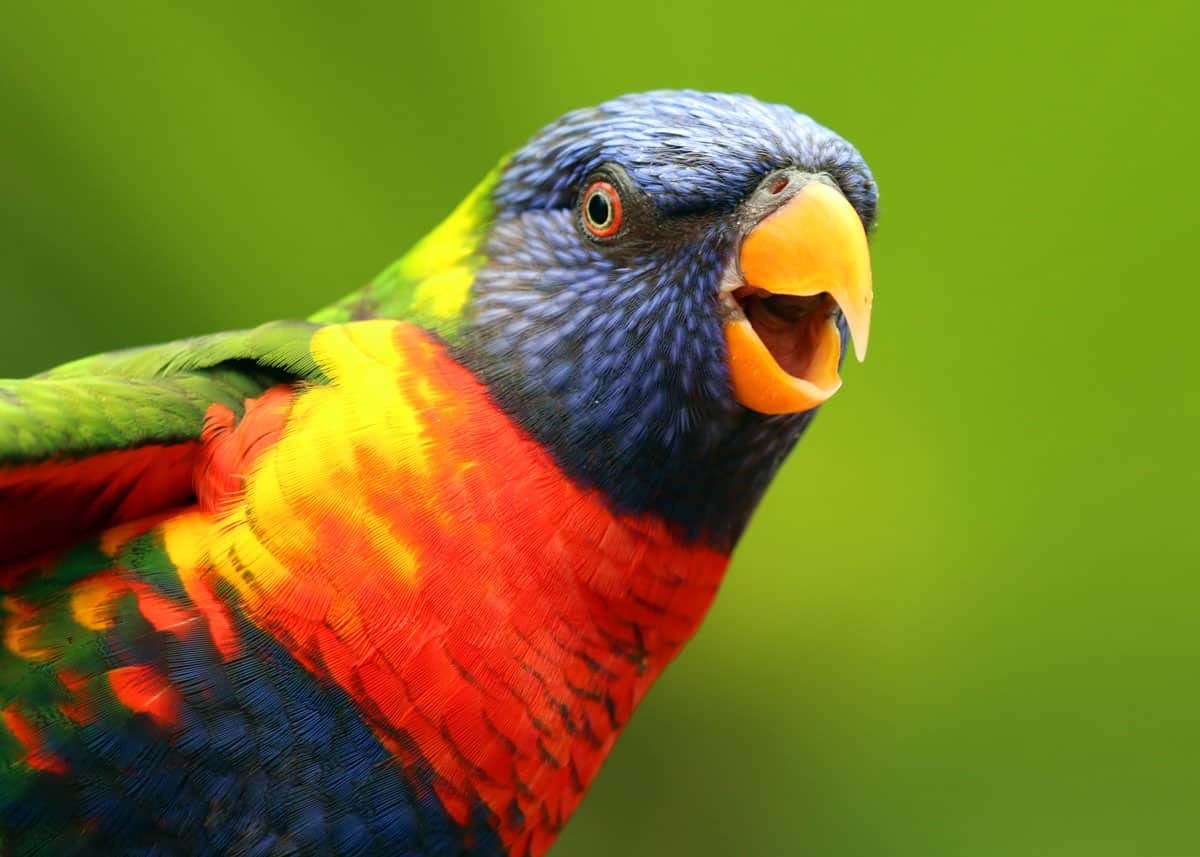
Table of Contents
26 of the Most Colorful Birds in the World
There are an estimated 10,000 birds species in the world, and thanks to bird experts and modern technology, we can learn about many of these birds with just a click of a computer mouse.
So let’s get into the amazing world of colorful birds!
1. Wilson’s Bird-of-Paradise
- Latin name: Diphyllodes respublica
- Unique colorful feature: Blue “bonnet” crown
- Where they are found: Indonesia
- Size: Length: 6.3 inches 16 cm (6.3 in); Weight 1.8 to 2.2 ounces (52 to 67 g)
- Diet: insects and fruit
One glimpse of Wilson’s bird of paradise and you’ll think it’s wearing a bluebonnet on its head.
That blue crown is actually bare skin with black feathers crisscrossing it.
The blue, green, and violet colors are caused by structural color as opposed to pigmented color.
I find structural color fascinating because you don’t always see the color the same way, it needs to catch the right light to be at its brightest.
Wilson’s bird-of-paradise species live in the lowland rainforests of Eastern Indonesia, Australia, and Papua New Guinea, feeding on fruits and insects.
The male has a funny mating ritual in which he diligently sweeps his territory clean of leaves and other debris before calling his mate and displaying his feathers to her in a courtship dance.
Learn more about how to identify bird calls here!
2. Red-necked Tanager
- Latin name: Tangara cyanocephala
- Unique colorful feature: Bright red neck
- Where they are found: Eastern South America
- Size: Length: 4 to 8 inches (10 to 20 cm); Weight: 28 ounces (8 g); Wingspan: 2.5 inches (62 mm)
- Diet: fruit and insects
To see the red-necked tanager you may need to plan a canopy tour in eastern Brazil, Paraguay or northeastern Argentina.
Considered one of the most colorful birds in the world, this vibrant tanager loves hanging out in the treetops and eating various fruits and insects.
Both male and female look similar although the male is much flashier.
These pretty tanagers are monogamous and lay between 2 and 4 eggs at a time.
3. Spangled Cotinga
- Latin name: Cotinga cayana
- Unique colorful feature: Turquoise body with purple throat
- Where they are found: South American rainforest
- Size: Length: 7 to 8 inches 20-21 cm); Weight: 2 to 2.5 ounces (55-75 g)
- Diet: small fruits
The beautiful male spangled cotinga is one of the many attractions of the Amazon Rainforest.
Female spangled cotingas are drabber looking with dull brown coloring and black mottling.
You won’t hear the spangled cotinga because it doesn’t vocalize, but it does make a whistling noise during flight.
This species is not monogamous, and the female takes full responsibility for her clutch of 1-4 eggs.
4. Mandarin Duck
- Latin name: Aix galericulata
- Unique colorful feature: Golden body with purple breast
- Where they are found: East Asia
- Size: Length: 16 to 18 inches (41 to 49 cm); Weight: 0.94 to 1.5 pounds (0.42 to 0.68 kg); Wingspan: 26 to 30 inches 65 to 75 cm)
- Diet: worms, mollusks, small fish, insects, and water plants
If you’re a romantic, you’ll probably fall in love with the mandarin duck.
Native to China and Japan, this species is regarded as the symbol of love and fidelity in Chinese, Japanese and Korean cultures due to the ducks’ monogamous habits.
The male is quite chivalrous as he often guards the female while she incubates their clutch of 9 to 12 eggs.
However, even if you aren’t into all that mushy stuff, you will appreciate the stunning beauty of the mandarin duck which features a combination of brilliant colors that include gold, green, blue, white and purple.
While some populations of this species have been released or escaped into Europe, Russia, and North America, the mandarin duck prefers lakes and marshy areas where it can feed on worms, mollusks, small fish, insects, and water plants.
On November 1st, 2018, the mandarin duck was spotted in New York’s central park.
5. Keel-billed Toucan
- Latin name: Ramphastos sulfuratus
- Unique colorful feature: Rainbow-colored bill
- Where they are found: Southern Mexico, Venezuela, Colombia
- Size: Length: 17 to 22 inches (42 to 55 cm); Weight: 4.7 to 8.8 pounds (2.1 to 4 kg); Wingspan: 43 to 60 inches (109 to 152cm)
- Diet: fruit and insects
You may recognize the keel-billed toucan from Kellogg’s Froot Loop cereal commercials.
This large, hollow beak can grow up to 7 inches long (20 cm), and the toucan uses it to spar with other males, attract females, and snatch fruit, insects, and bird eggs.
Keel-billed toucans love flocking together in groups of about 20 individuals and sleeping in tree cavities in the jungles of Central and South America.
They are monogamous throughout the breeding period and both males and females share in the parenting duties that include incubating one to five eggs and feeding the young.
6. Western Crowned Pigeon, a.k.a Blue-Crowned Pigeon
- Latin name: Goura cristata
- Unique colorful feature: Lacy blue crest
- Where they are found: Western New Guinea
- Size: Length: 28 inches (66 to 75 cm); Weight: 4.6 pounds (1800–2400 g)
- Diet: fruit, seeds, and insects
Also known as the western-crowned pigeon, the blue-crowned pigeon is no ordinary pigeon and is considered to be one of the most beautiful pigeons in the world.
Native to Papua New Guinea, this species lives in small flocks among marshes and lowland rainforests, feeding on insects, seeds, grains, and fruits such as figs.
Blue-crowned pigeons pair for life and their courtship ritual is every bit as elaborate as their appearance.
The male fans his tail and wing feathers wide while bowing to the female with a booming call.
The female, who looks similar in appearance, will then dance around him. The male then offers nesting materials to the female.
Both birds will build the nest and incubate a single egg together. After the chick hatches, both mom and dad will feed it with milk made from their partially digested food.
7. Lady Gouldian Finch
- Latin name: Erythrura gouldiae
- Unique colorful feature: Multicolored block stripes
- Where they are found: Northwestern Australia
- Size: Length: 5 inches (130 mm); Weight: 0.42 ounces (11.9 g)
- Diet: seeds
This colorful species can be seen in mixed flocks foraging on various grass seeds across northwestern Australia.
Science has shown that when one of these rainbow finches mates with another of a different color head (red or black), the mortality rate of the offspring can go up to 80%.
Interestingly, the birds themselves somehow know this and will mate with individuals of both red and blackheads to bolster the odds for their offspring.
8. Common Kingfisher
- Latin name: Alcedo atthis
- Unique colorful feature: Teal blue with orange underparts
- Where they are found: Worldwide
- Size: Length: 6 to 7 inches long (17 to 19 cm); Weight: 1.2 to 1.6 ounces (34 to 46 grams); Wingspan: 9.8 inches (25 cm)
- Diet: small fish
Found all over the world nearby ponds, rivers and lakes, these little birds have an amazing knack for diving into the water and snagging its prey of small fish or crustaceans with its long, dagger-like beak.
Common kingfishers prefer to be loners and only pair up with others during mating season.
To win over a female, a male will offer a fish to her. If she accepts his gift, the two will then make a nest together in a bank burrow, tree hollow or termite mound.
After the female lays three to six eggs, both parents will share in brooding and raising the chicks until they are a few months old.
9. Red-bearded Bee-Eater
- Latin name: Nyctyornis amictus
- Unique colorful feature: Reddish-orange throat and chest
- Where they are found: Indo-Malayan region of Southeast Asia
- Size: Length: 10 to 12 inches (27 to 31 cm); Weight: 2.15 to 3.25 ounces (61–92 g)
- Diet: insects
You’re most likely to see a red-bearded bee-eater in a dense forest, perched perfectly still while it waits for food to fly by, which includes not just bees but wasps, hornets, and other insects as well.
Considered monogamous, red-bearded bee-eaters often nest in tunneled burrows of sandy river banks, brooding over 2 to 9 eggs.
Both parents share in the feeding and raising of the chicks.
10. Paradise Tanager
- Latin name: Tangara chilensis
- Unique colorful feature: Apple-green head and bright blue belly
- Where they are found: Amazon Basin of South America
- Size: Length: 5.5 inches (14 cm); Weight: 63 to 74 ounces (18-21 g)
- Diet: insects
This little songbird beauty would be a delight to spot while touring the canopy forest in the tropical Amazon Basin across Peru, Brazil, Colombia, Bolivia, and Ecuador.
These pretties can be seen in mixed flocks while feeding on insects such as grasshoppers and spiders.
Paradise tanagers may raise up to three broods of 2 to 4 eggs per each breeding season. The female builds the nest high in the treetops out of moss, grass and spider web while the male has the easy job of singing nearby.
11. Lilac-breasted Roller
- Latin name: Coracias caudatus
- Unique colorful feature: Lilac throat with multicolored body
- Where they are found: Eastern and Southern Africa
- Size: Length: 14.5 inches (37 cm); Weight: 3.6 ounces (104 g)
- Diet: insects, arthropods, and small rodents
It’s no wonder that the lilac-breasted roller is the unofficial national bird of both Kenya and Botswana. Who wouldn’t want to claim one of the world’s most colorful birds?
With both male and female of this species looking similar in appearance, these birds diet on grasshoppers, lizards, scorpions, beetles, crabs, snails, and rodents.
Like other rollers, this lilac-breasted species knows how to put on an impressive courtship display by diving and rolling in the air with loud and rowdy sounds.
These monogamous birds prefer to nest in ready-made holes previously created by kingfishers and woodpeckers. They usually lay 2 to 4 eggs which are incubated by both parents.
12. Andean Cock-of-the-Rock
- Latin name: Rupicola peruvianus
- Unique colorful feature: Bright reddish-orange head, throat, breast, and shoulders
- Where they are found: Northwestern South America
- Size: Length: 13 inches long (32 cm); Mass weight: 8 ounces (220 g)
- Diet: fruit and small amphibians
These birds get their name from the fact that they love to hang out on rocks and ledges in the cloud forests of the Andes Mountains from Venezuela to Bolivia.
They can sometimes be seen feeding among fruit trees, but they will also eat small amphibians.
Highly polygamous, the male cock-of-the-rock spends a great deal of his time strutting his stuff to attract as many females as he can with head-bobbing, wing flapping and bowing.
A female will peck at the male’s neck when she chooses him for a mate. Afterward, the female will raise her brood of usually two chicks by herself.
13. Crimson Rosella
- Latin name: Platycercus elegans
- Unique colorful feature: Crimson head and body
- Where they are found: Eastern and Southeastern Australia, New Zealand
- Size: Length: 10 to 14 inches (25 to 36 cm); Mass weight: 4.2 ounces (119 g)
- Diet: seeds, insects, and fruit
Like other parrots, crimson rosellas are intelligent and playful and often make loud piercing noises, squawks and whistles.
Even if you don’t see him at first, you would hear him noisily chattering with all his buddies as they forage for seeds, fruits, herbs, and insects in the wet forests of Southeastern Australia and New Zealand.
However, during the breeding season, mating pairs prefer to be alone instead of hanging with the gang. During the breeding season, these monogamous birds build their nests in tree hollows from wood shavings.
The female incubates 3 to 8 eggs and feeds the hatchlings for the first few days. Afterward, both parents will raise the chicks.
14. American Purple Gallinule
- Latin name: Porphyrio martinicus
- Unique colorful feature: Violet plumage on head and breast
- Where they are found: Southeastern United States and Central America
- Size: Length: 10 to 15 inches (26–37 cm); Mass weight: 5.0 to 10.8 ounces (141 to 305 g); Wingspan: 20 to 24 inches (50 to 61 cm)
- Diet: fish, plants, fruits, and snails
This striking bird likes to hide in the cover of reeds and aquatic vegetation around swamps, lagoons, ponds and freshwater marshes along the coasts of the Southeastern United States and Central America.
The purple gallinule is an eye-catching bird with its iridescent violet plumage, shimmering green wings, blue head, and a red beak.
Adding to this colorfulness are the bird’s long yellow legs and long toes that enable it to walk on floating water plants.
You can spot this colorful bird during the day when it’s feeding on plants, insects, frogs, worms, and snails.
Purple gallinules can swim but prefer to stay out of open water away from predators like alligators.
These monogamous birds are highly territorial during breeding season as they guard and incubate their floating nest of 2 to 10 eggs.
15. Splendid Fairy Wren
- Latin name: Malurus splendens
- Unique colorful feature: Bright blue plumage
- Where they are found: Australia
- Size: Length: 5.5 inches (14 cm); Weight: 0.35 ounces (10 g)
- Diet: fruit, insects, and seeds
This species is found living in groups and foraging together for seeds, fruit, and insects in the shrublands and woodlands of Australia.
He loves to charm the ladies (who are mostly brown) by offering them pink and purple flower petals from his beak.
Even after choosing a mate, this loverboy and his girl both practice promiscuity which works for them because all the birds involved in the lovers’ trysts help take care of the offspring.
16. Curl-crested Aracari
- Latin name: Pteroglossus beauharnaesii
- Unique colorful feature: Blue-ringed eye and multi-colored body
- Where they are found: Amazon Basin in South America
- Size: Length: 16 to 18 inches (40 to 45 cm); Weight: 6.7 to 9.9 ounces (190 to 280 g)
- Diet: fruit
This toucan hangs out with his own peeps while foraging in fruit trees in the lowland forests of Western Brazil, Northern Peru, and Central Bolivia.
As monogamous birds, both male and female make their nest together in former woodpecker hollows and share in the incubation and raising of 3 to 4 eggs.
17. Indian Peafowl (Peacock)
- Latin name: Pavo cristatus
- Unique colorful feature: A dazzling blue and green breast and a yellow, green, and blue tail fan
- Where they are found: Southeast Asia
- Size: Length: 3.3 to 3.8 feet (1.0 to 1.15 m); Weight: 8.8 to 13 pounds (4 to 5 kg); Wingspan: Avg. 5 feet (1.5 m)
- Diet: insects, fruit, and seeds
No list of the world’s most colorful birds would be complete without the Indian peafowl, more casually known as the peacock.
|
The male is famous for his dazzling display of tail feathers that fan out to about 5 feet (1.5 m) in colors of green, blue and yellow, dotted by eyespots of the same colors.
Adding to his beauty is a metallic blue-green throat, chest, and fancy crest.
The polygamous male uses his glorious tail display to attract females (peahens) which are overall brown in color.
The national bird of India, this peafowl is native to India and is also commonly found in Sri Lanka and other countries of South Asia but has been widely introduced all over the world.
In the wild, Indian peafowls feed on seeds, fruits, and insects and make their nests on the ground with the female taking sole responsibility for 4 to 8 chicks.
18. Northern Cardinal
- Latin name: Cardinalis cardinalis
- Unique colorful feature: Bright red plumage
- Where they are found: Eastern and Central North America
- Size: Length: 8 inches (20.32 cm); Weight: 1.6 ounces (45.35 g) Wingspan:11 inches (27.94 cm)
- Diet: Seeds and insects
You may know cardinals from some very beautiful winter greeting cards.
Native to eastern and central United States and Canada, these little lovelies can be spotted in woodlands as well as urban parks and gardens, foraging for seeds and insects.
Here’s how to get more cardinals at your feeder!
Northern cardinals get their name from the Roman Catholic cardinals who wear red robes and caps.
This songbird species is monogamous and during the breeding season, the male will husk seeds and feed them to his mate.
A pair will usually raise two broods each season with an average of three eggs for each nest.
19. Painted Bunting
- Latin name: Passerina ciris
- Unique colorful feature: Rainbow-colored plumage
- Where they are found: Southeastern United States
- Size: Length: 4.7 to 6 inches (12 to 15 cm); Weight: 0.46 to 0.7 oz (13 to 20 g); Wingspan: 9 inches (23 cm)
- Diet: insects and seeds
It’s no surprise that the painted bunting is often called a rainbow bunting. The female is mostly green.
Painted buntings are shy birds and prefer to stay under the cover of trees and shrubs but will come out to bird feeders and to search for grass seeds and insects.
Seasonally monogamous, the males will establish the breeding territory a week before the females arrive. Once the ladies come on the scene, the males go all out to show off their colorful feathers and courtship displays.
The female builds a nest of moss, grass, and twigs where she will brood a clutch of 3 to 5 eggs.
20. Scarlet Macaw
- Latin name: Ara macao
- Unique colorful feature: Scarlet red head and body with multi-colored wings
- Where they are found: Central and South America
- Size: Length: 33 inches (84 cm); Weight: 2.2 pounds (1 kg)
- Diet: berries, nuts, seeds, and insects
While they love to squawk and screech loudly, scarlet macaws are some of the most intelligent birds in the world.
They can learn to talk (mimic a wide range of human words) and mimic other animal sounds as well as distinguish shapes and colors.
While these parrots mostly eat nuts, seeds, berries, and insects, they can often be seen in a flock eating clay from riverbanks, which is believed to neutralize toxins found in some plant species eaten by these parrots.
Scarlet macaws can also fly up to 35 mph and live for about 50 years in the wild.
Monogamous birds and devoted parents, scarlet macaws raise 2 to 3 chicks at a time, but they will not breed again for about a year or more later until the juveniles are totally ready for independence.
21. Resplendent Quetzal
- Latin name: Pharomachrus mocinno
- Unique colorful feature: Metallic green and blue plumage with a red chest
- Where they are found: Central America
- Size: Length: 14 to 16 inches (36 to 40.5 cm); Weight: 6.5 to 8 ounces (180 to 225 g)
- Diet: fruit and insects
Once considered sacred to the ancient Aztec and Mayan cultures, resplendent quetzals often accompanied chiefs into battle, and priests wore the birds’ brilliant feathers during important ceremonies.
As the breeding season begins, the male grows a long train of streaming blue-green feathers which he uses to attract a female in elaborate flight displays.
Once the male is accepted, the seasonally monogamous pair will construct a nest in a dead tree cavity and alternately incubate a clutch of two eggs.
22. Rainbow Lorikeet
- Latin name: Trichoglossus moluccanus
- Unique colorful feature: Rainbow-colored plumage
- Where they are found: Northern and Eastern Australia
- Size: Length: 10 to 12 inches (25 to 30 cm); Weight: 2.6 to 5.5 ounces (75 to 157 g)
- Diet: seeds, succulent plants, pollen, nectar, fruit, and insects
If you ever see a flock of these rainbow lorikeets in the woodlands or coastal regions of Eastern and Northern Australia, you might think you’re looking through a kaleidoscope.
When not hanging with the flock, these monogamous birds will travel in pairs as they frequently visit bird feeders and forage for seeds, fruit, and insects as well as collecting nectar and pollen.
They are friendly and affectionate birds, often nuzzling each other. They make their nests in the hollows of palm trees and eucalyptus trees with other birds, brooding between one and three eggs.
23. Scarlet-chested Parakeet
- Latin name: Neophema splendida
- Unique colorful feature: Scarlet red breast and multi-colored body
- Where they are found: Southern and Western Australia
- Size: Length: 7.5 to 8 inches (19 to 20 cm): Weight: 1.3 to 1.5 ounces (36 to 44 g)
- Diet: succulent plants and seeds
Thee little birds are gentle with charming personalities and keep up a constant, soft twitter when flocking in trees together in Western and Southern Australia.
Inhabiting dry grasslands and shrublands, they eat grass seeds and succulent plants which enable them to go long periods without water.
These parakeet species can yield up to three clutches each year with 3 to 6 eggs each time.
24. Flamingo
- Latin name: Phoenicopteridae
- Unique colorful feature: Pink plumage
- Where they are found: Every continent except Antarctica
- Size: Height: 4 to 5 feet (1.21 to 1.52 m); Weight: 5 to 7 pounds (2.5 to 3.5 kg); Wingspan: 3 to 4 feet (0.91 to 1.21 m)
- Diet: algae and fish
These tall wading birds like to flock together in large colonies around lakes and lagoons where they do everything in unity from eating to elaborate mating dances.
They even all breed at the same time so that their single chicks each all hatch around the same time.
Flamingos also have a unique behavior where they often stand on one leg. There are many theories about why they do this, but no one is certain about the reason yet.
25. Golden Pheasant a.k.a Red Golden Pheasant or Chinese
Pheasant
- Latin name: Chrysolophus pictus
- Unique color feature: Golden-headed orange throat
- Where are they found: Western China, much of Noth and South America and Europe
- Size: Height: 3.5 ft (1.06 m)
- Diet: seeds, berries, and grubs
Golden pheasants are simply amazing! They may not be very big, but they make a big impression.
The male golden pheasant sports his namesakes golden head and lower back as well as gorgeous red underbody and orange and black striped neck.
He has an iridescent green-blue patch on his back and some long red and brown tail feathers.
Golden pheasants are polygamous and lay up to 12 eggs every breeding season. These eggs take up to 23 hatches.
26. Nicobar Pigeon
- Latin name: Caloenas nicobarica
- Unique color feature: iridescent plumage
- Where are they found: Nicobar Islands
- Size: 1.4 ft (0.5 m)
- Diet:
Nicobar pigeons are quite similar to other pigeons, except for one important difference – their fascinating colors.
These gorgeous pigeons have a grey head and iridescent plumage over almost their entire bodies.
Their feathers shine green, blue, red, and purple; depending on how the light catches them.
These monogamous pigeons build small nests and lay only one blueish egg. This bird’s colorful plumage is definitely one of my favorites!
Living Rainbows
We hope you enjoyed this list of the most colorful birds on the planet.
Want more? Check out our picks for the weirdest birds on the planet!
Which bird was your favorite? Have you seen any of these birds in person? Are there any birds we should add to the list? Let us know in the comments, we love hearing from you!
Drew Haines is an animal enthusiast and travel writer. She loves to share her passion through her writing.
She graduated high school at sixteen and started her own business, Everywhere Wild Media. And she runs Everywhere Wild and JustBirding. She also guest blogs on Storyteller.Travel
She lived in Ecuador for 6 years and explored the Galapagos Islands. Currently based in N.S., Canada.

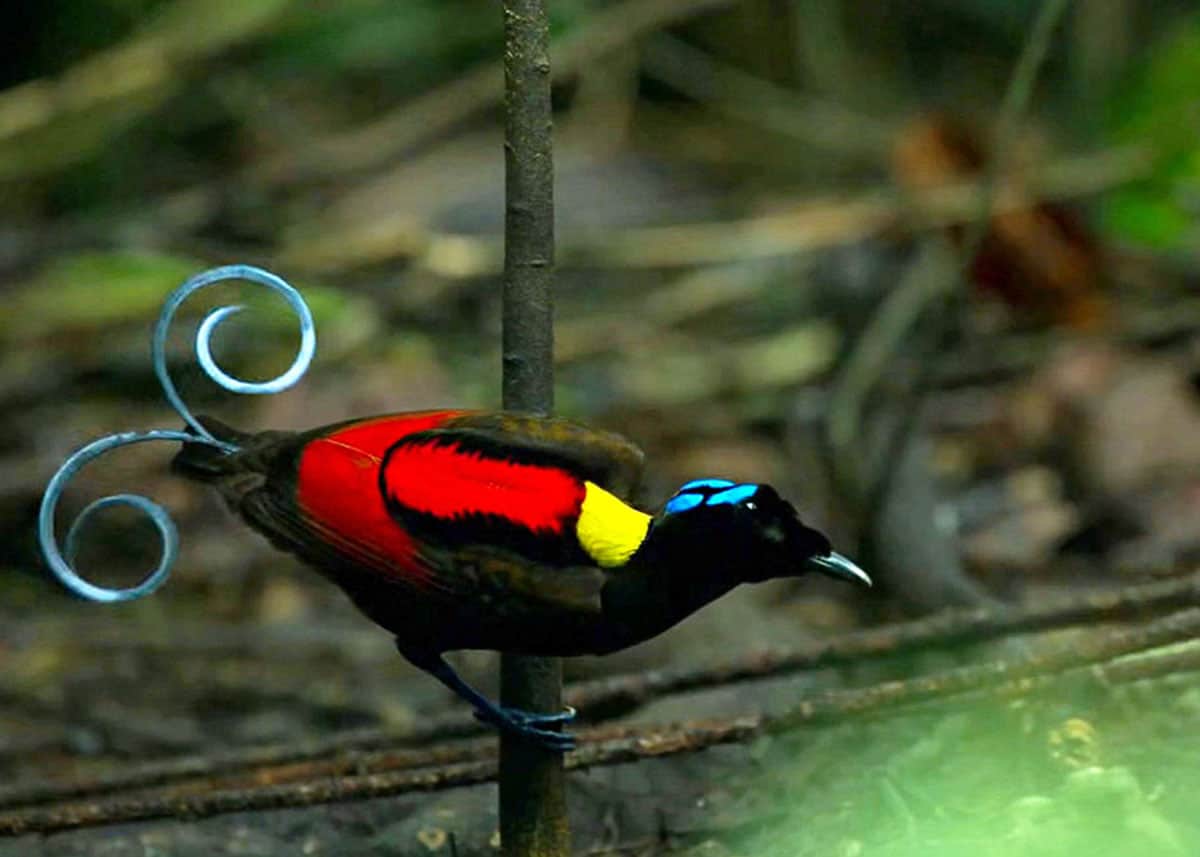
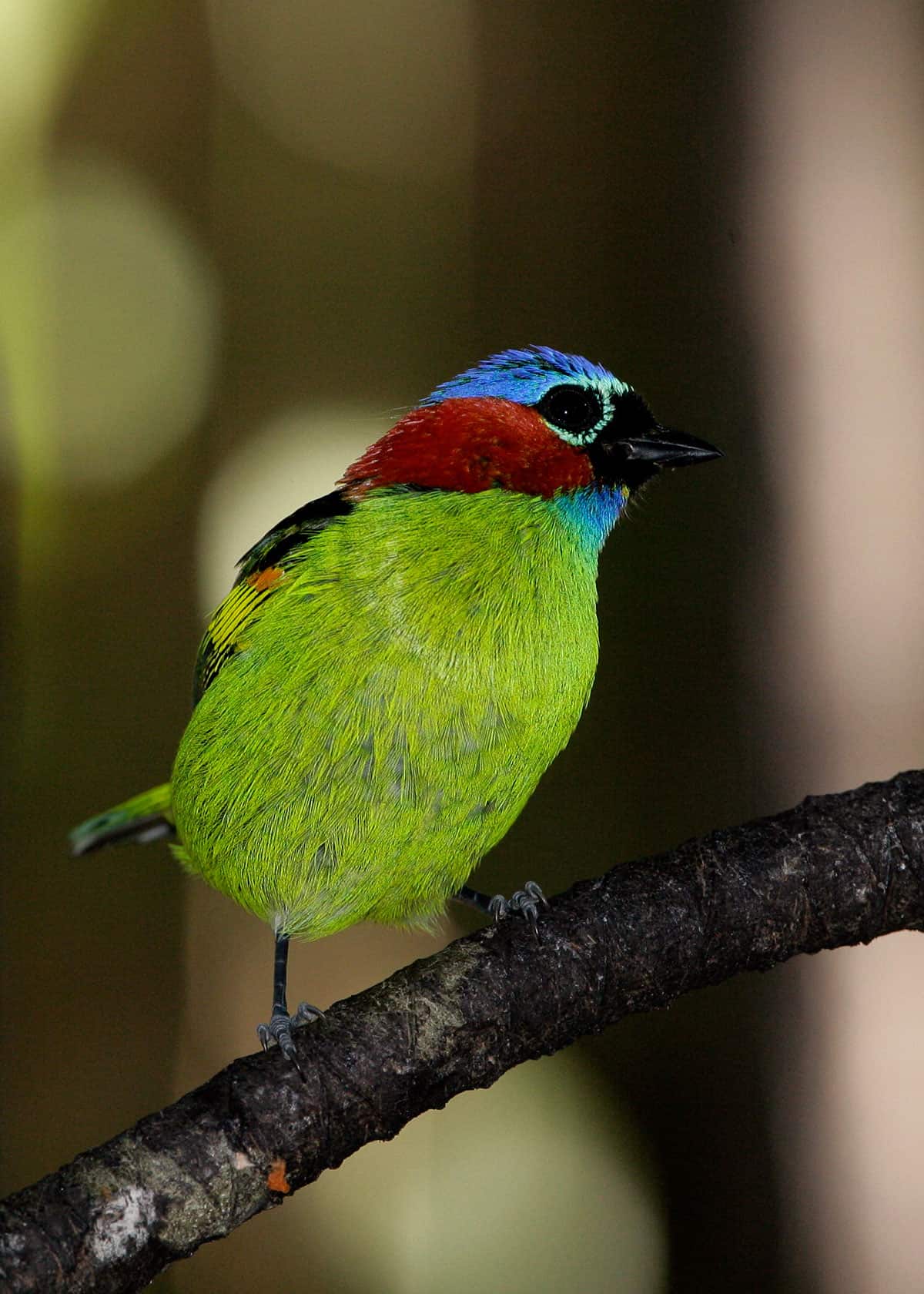
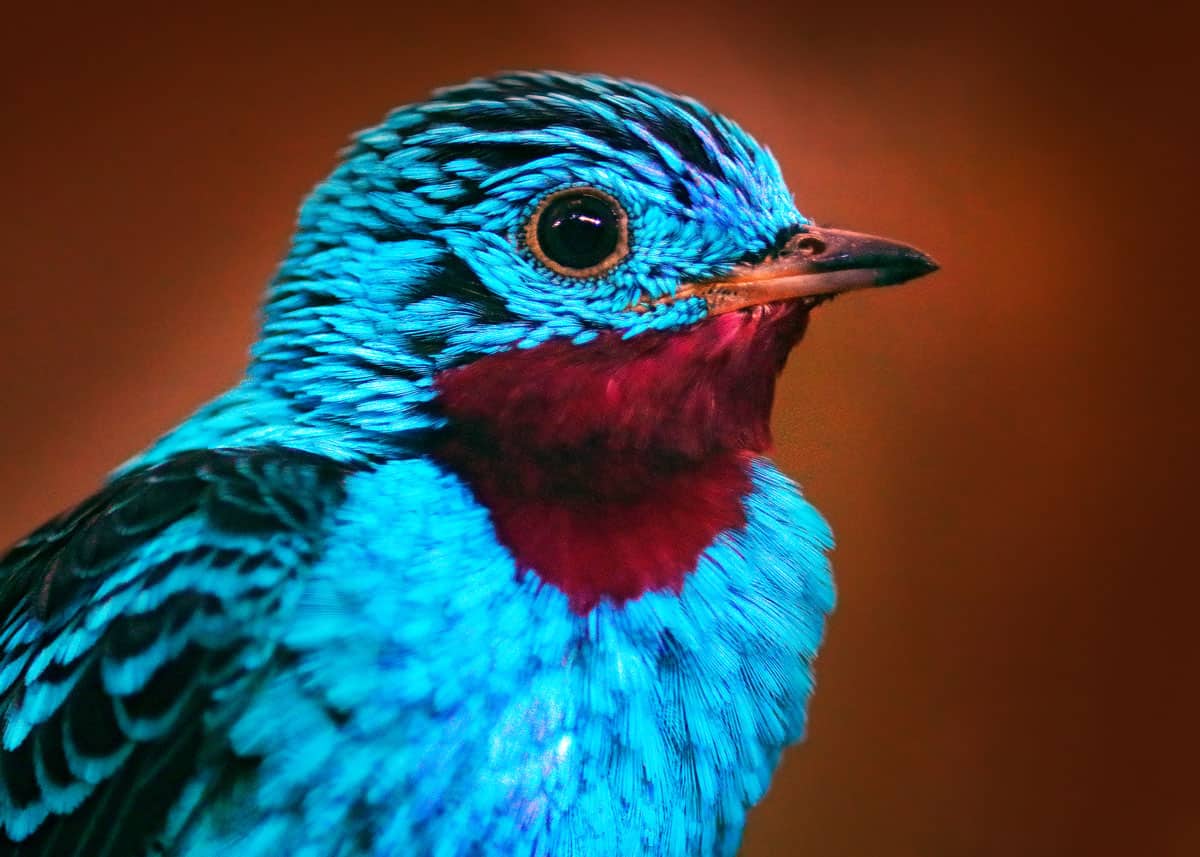
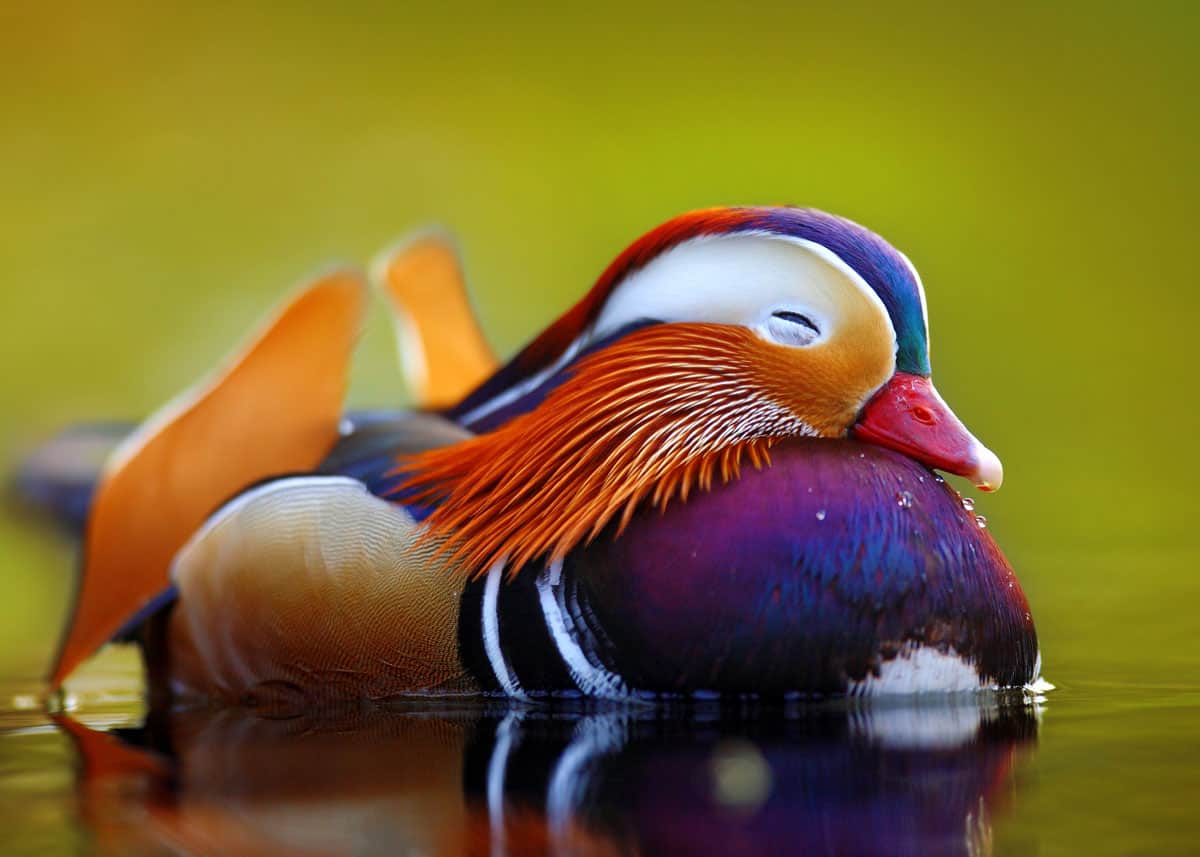

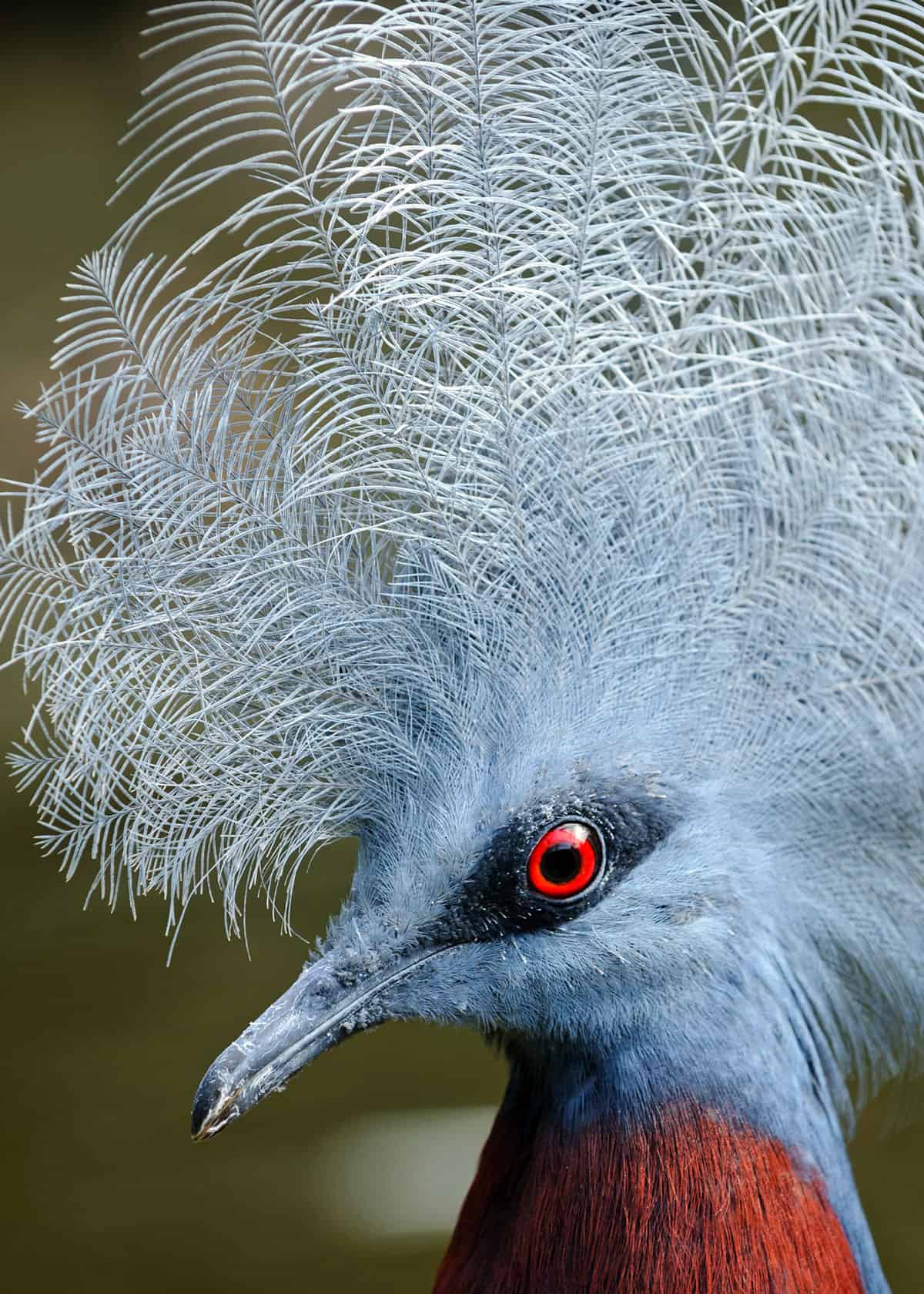
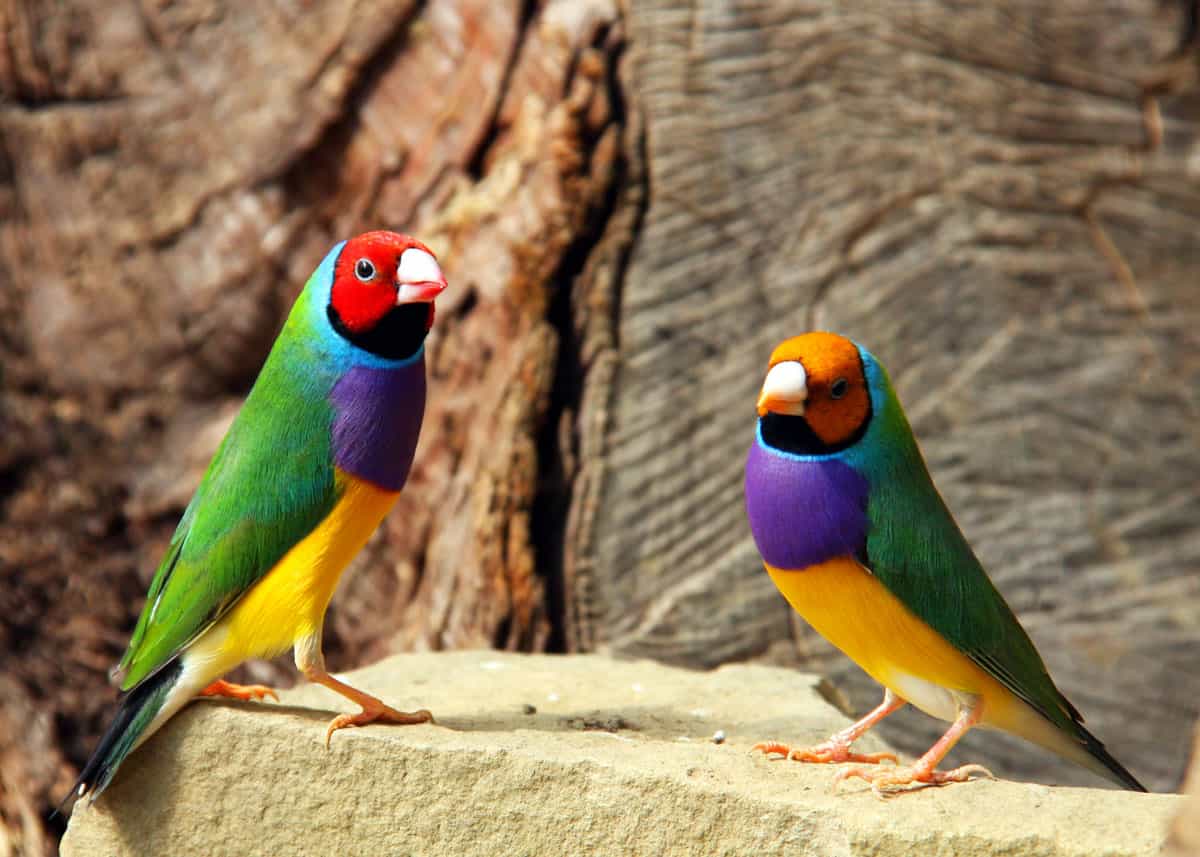
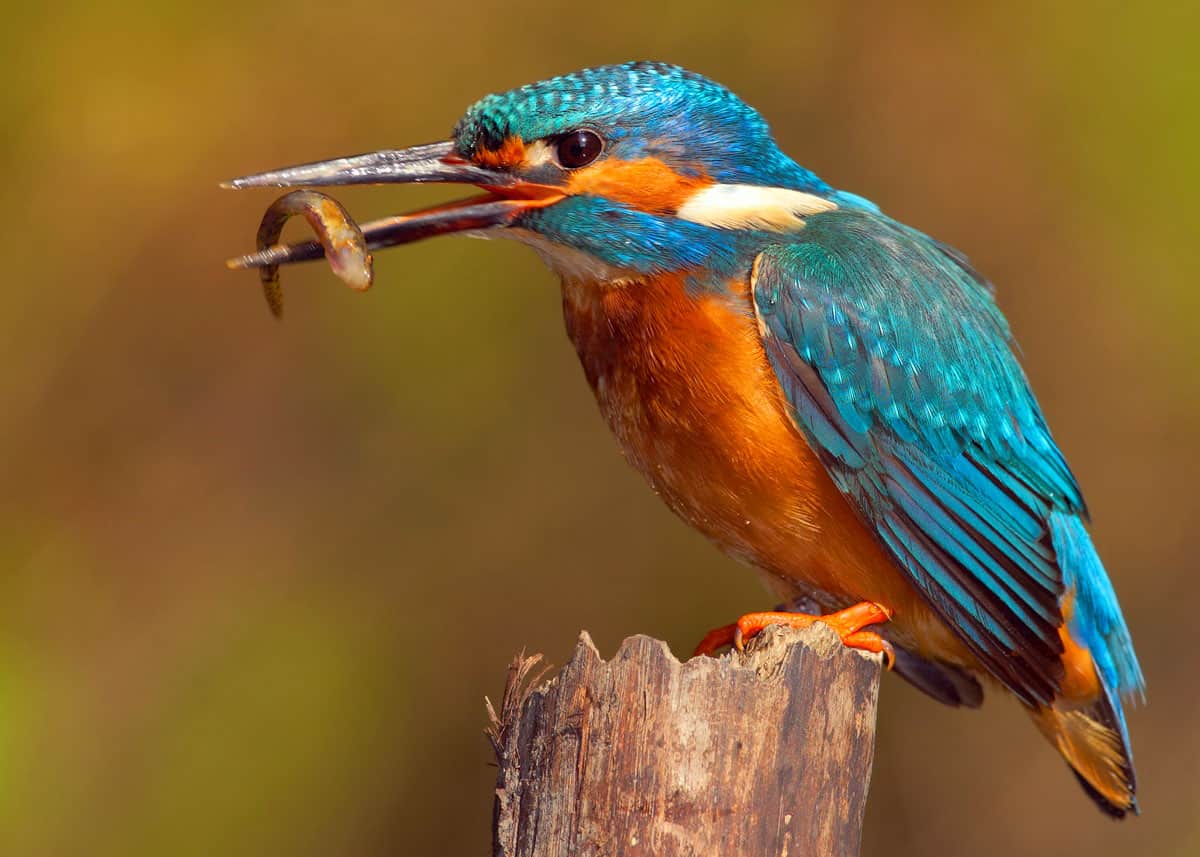
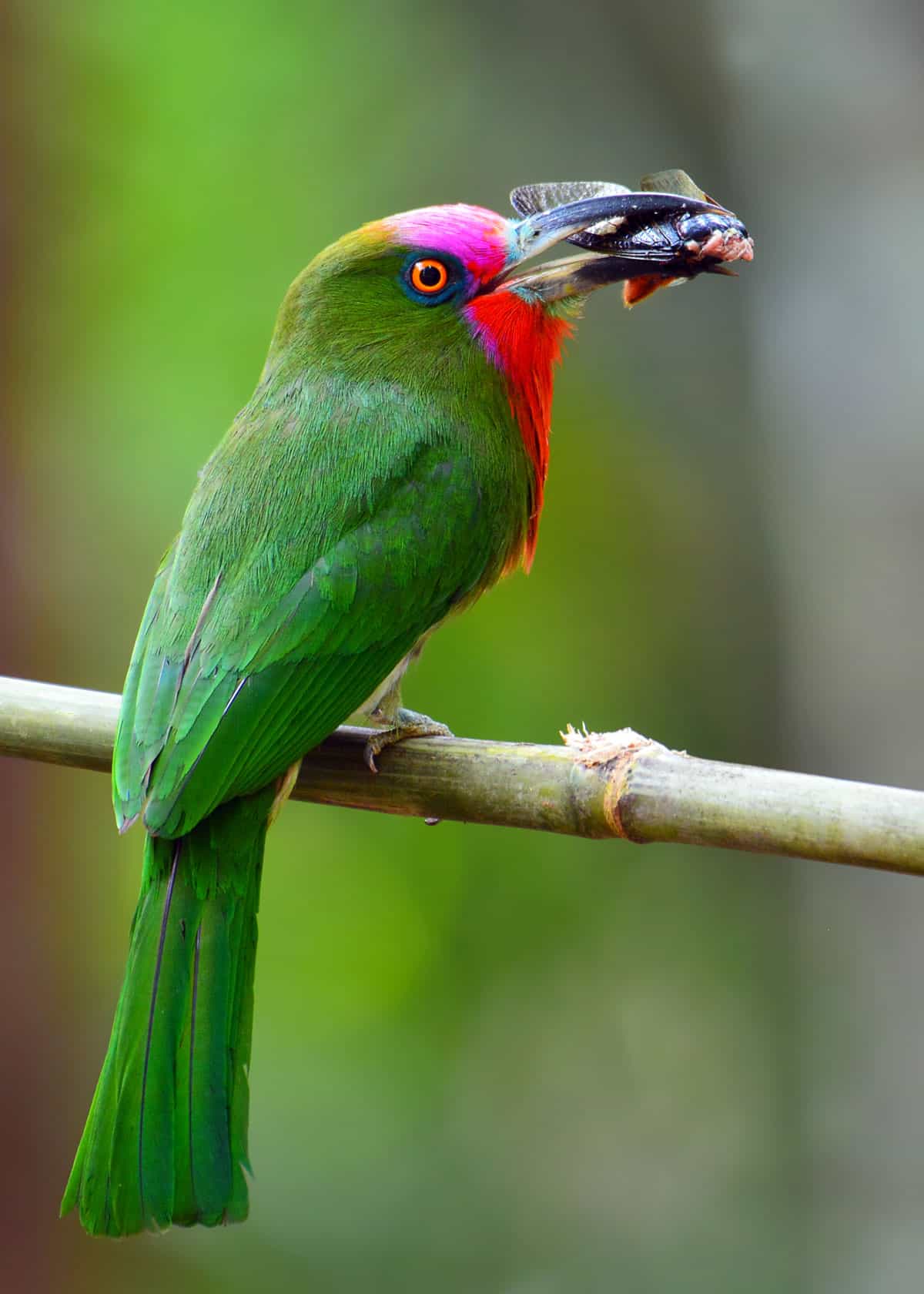
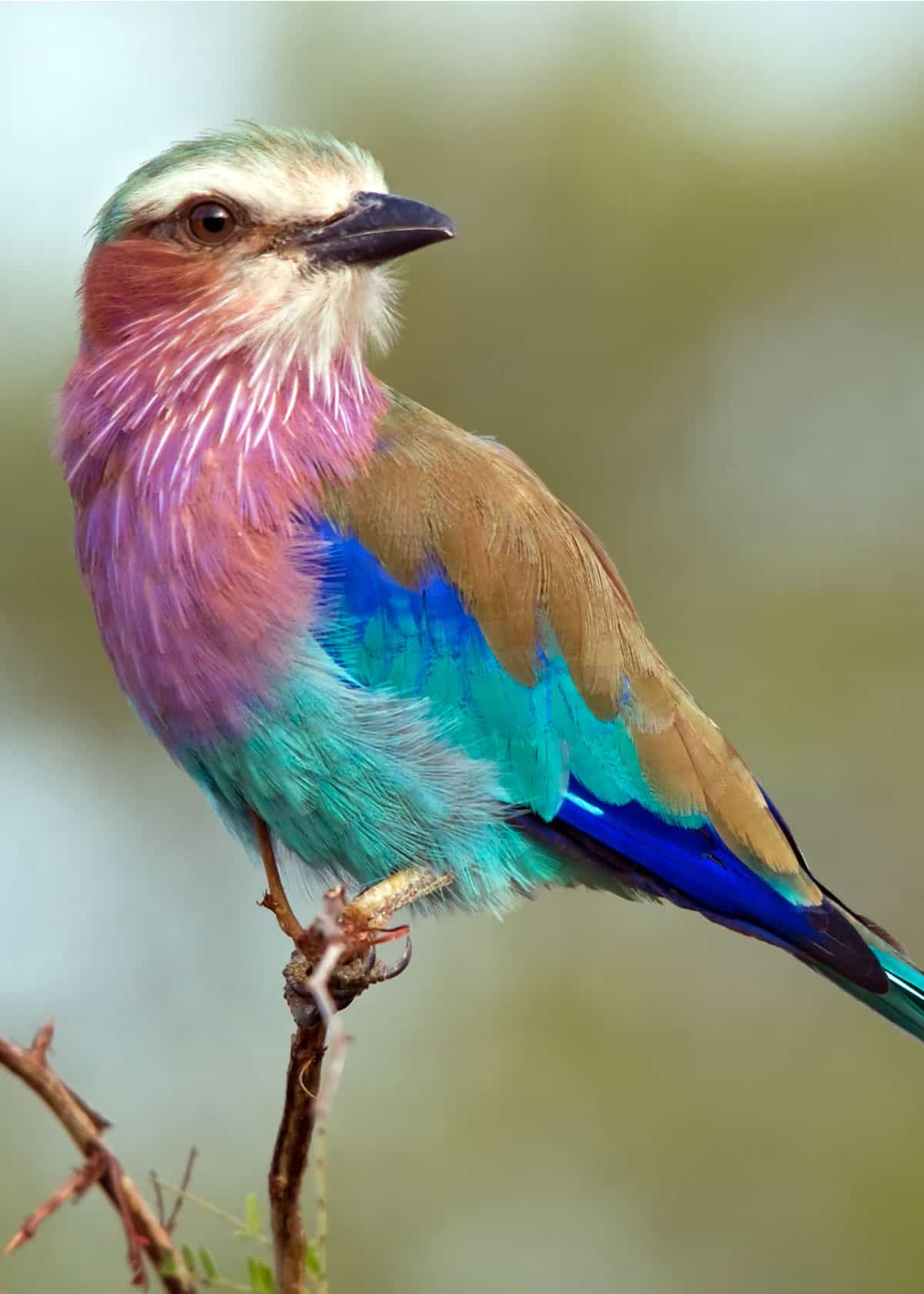
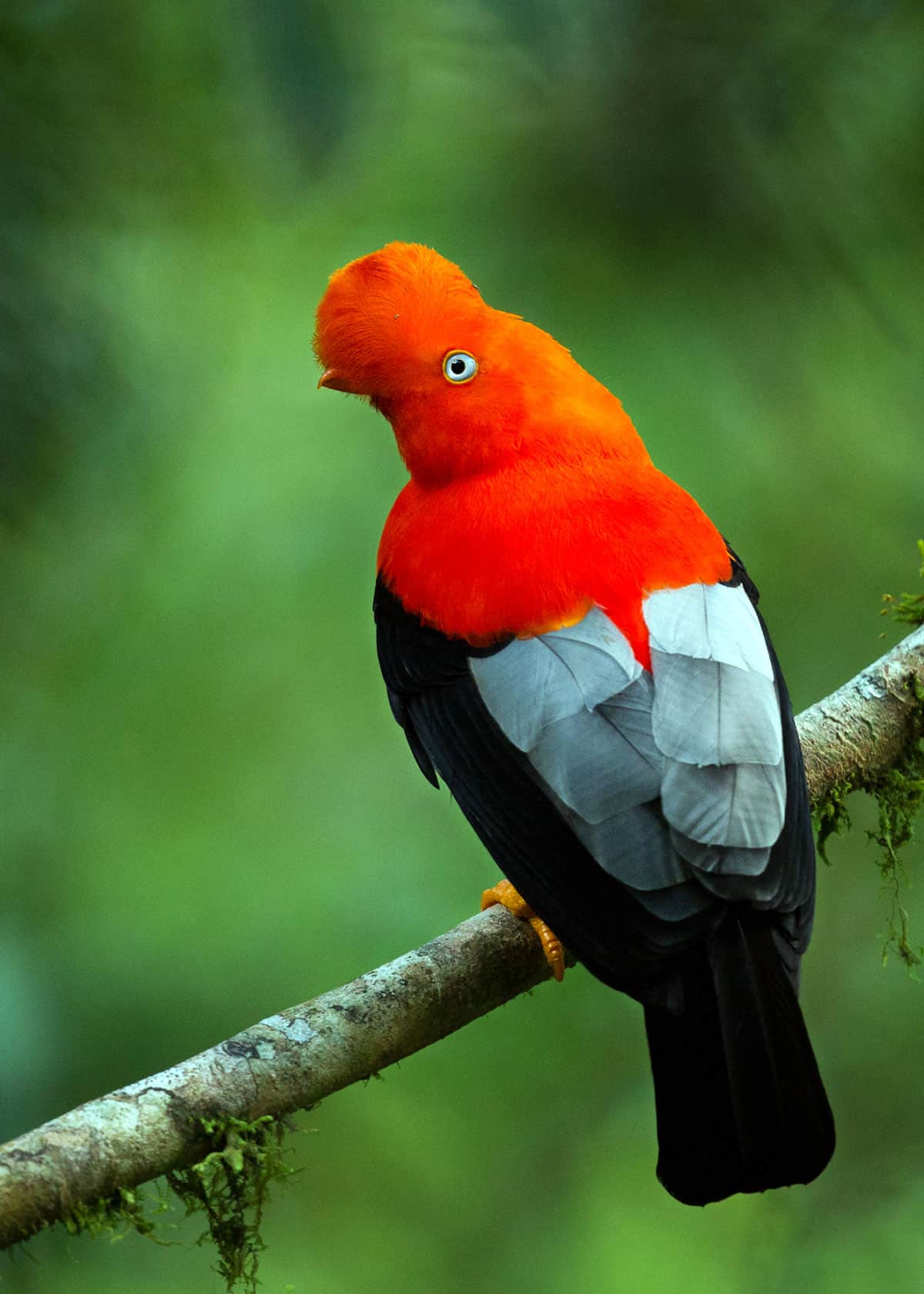
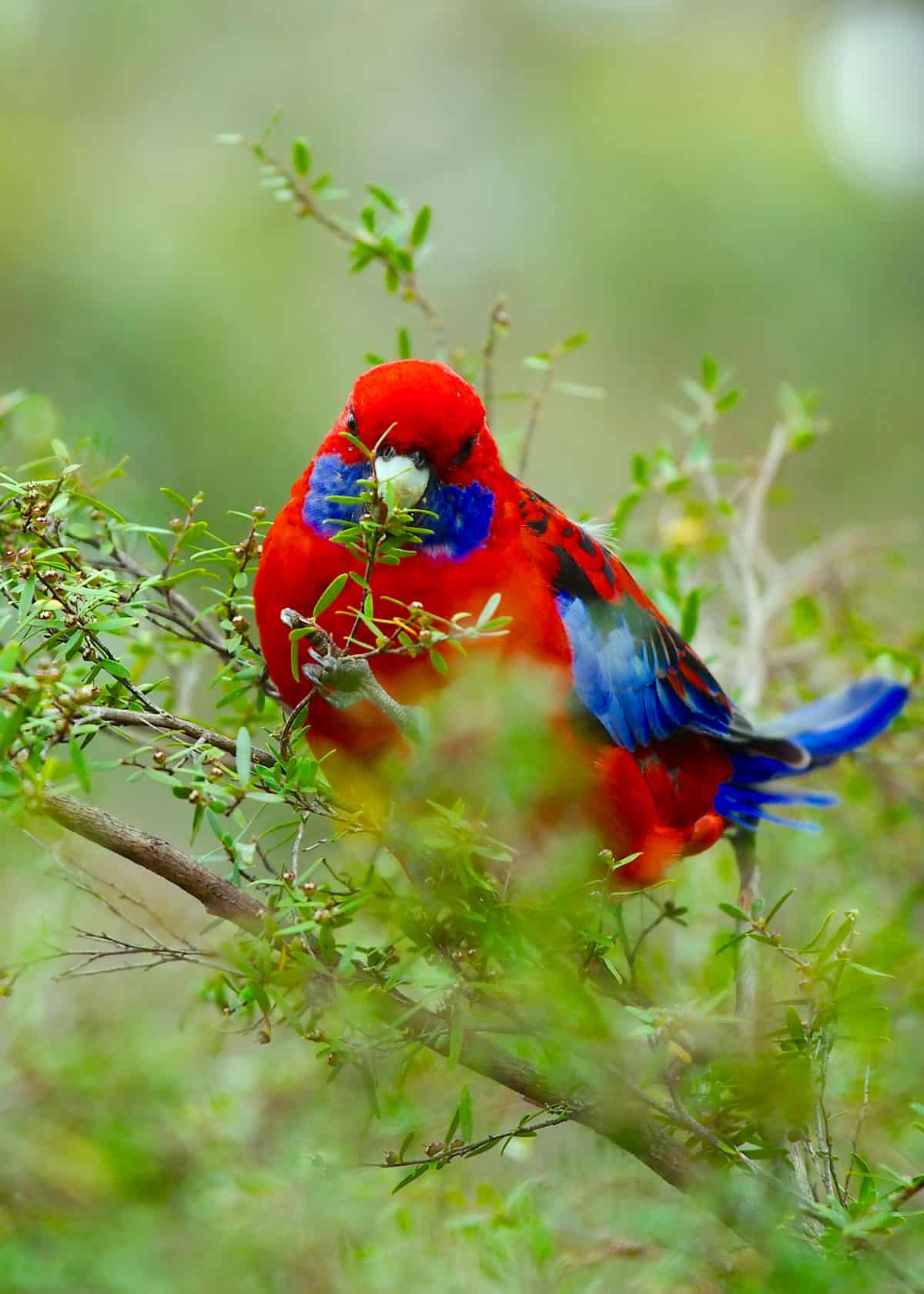
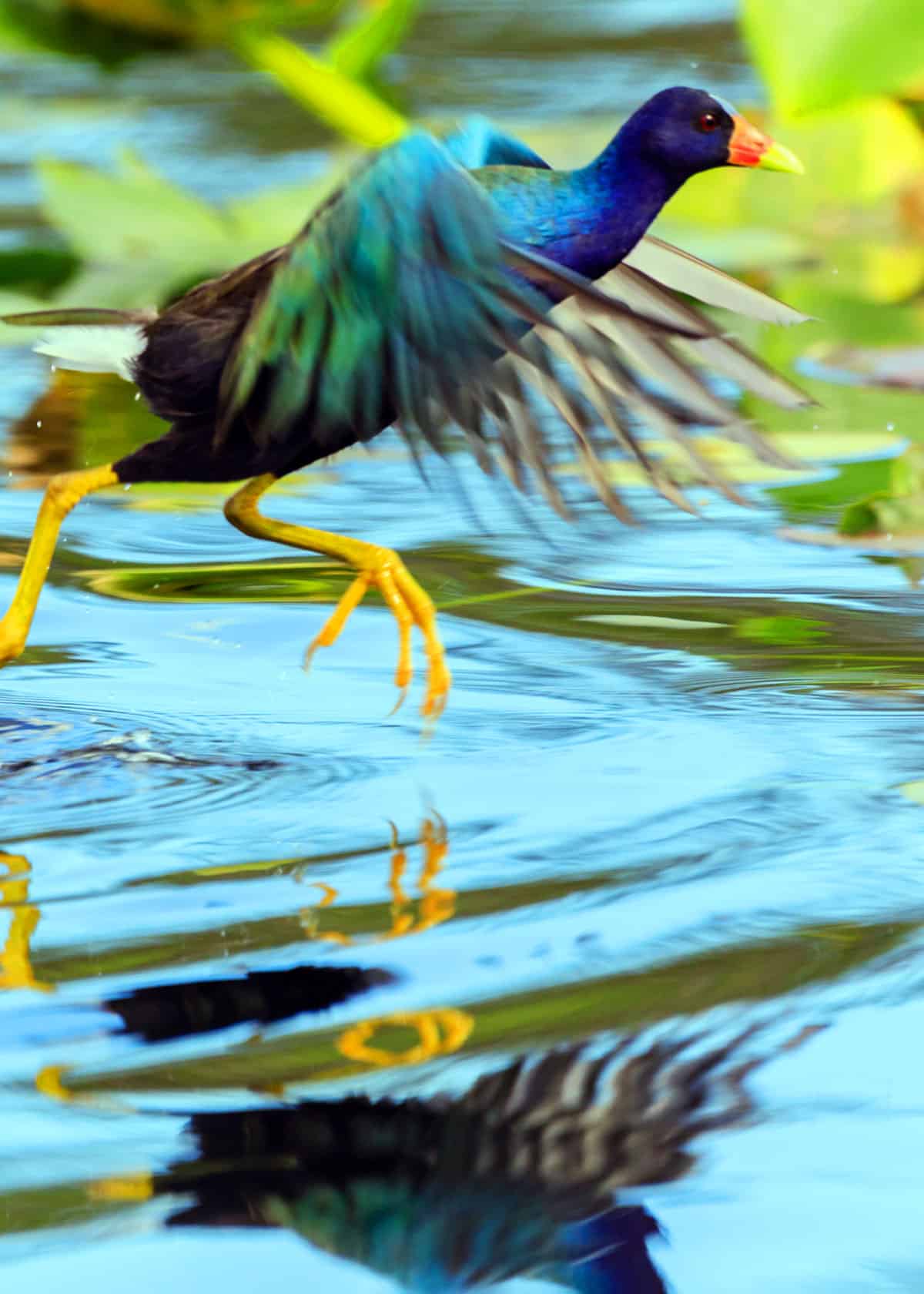
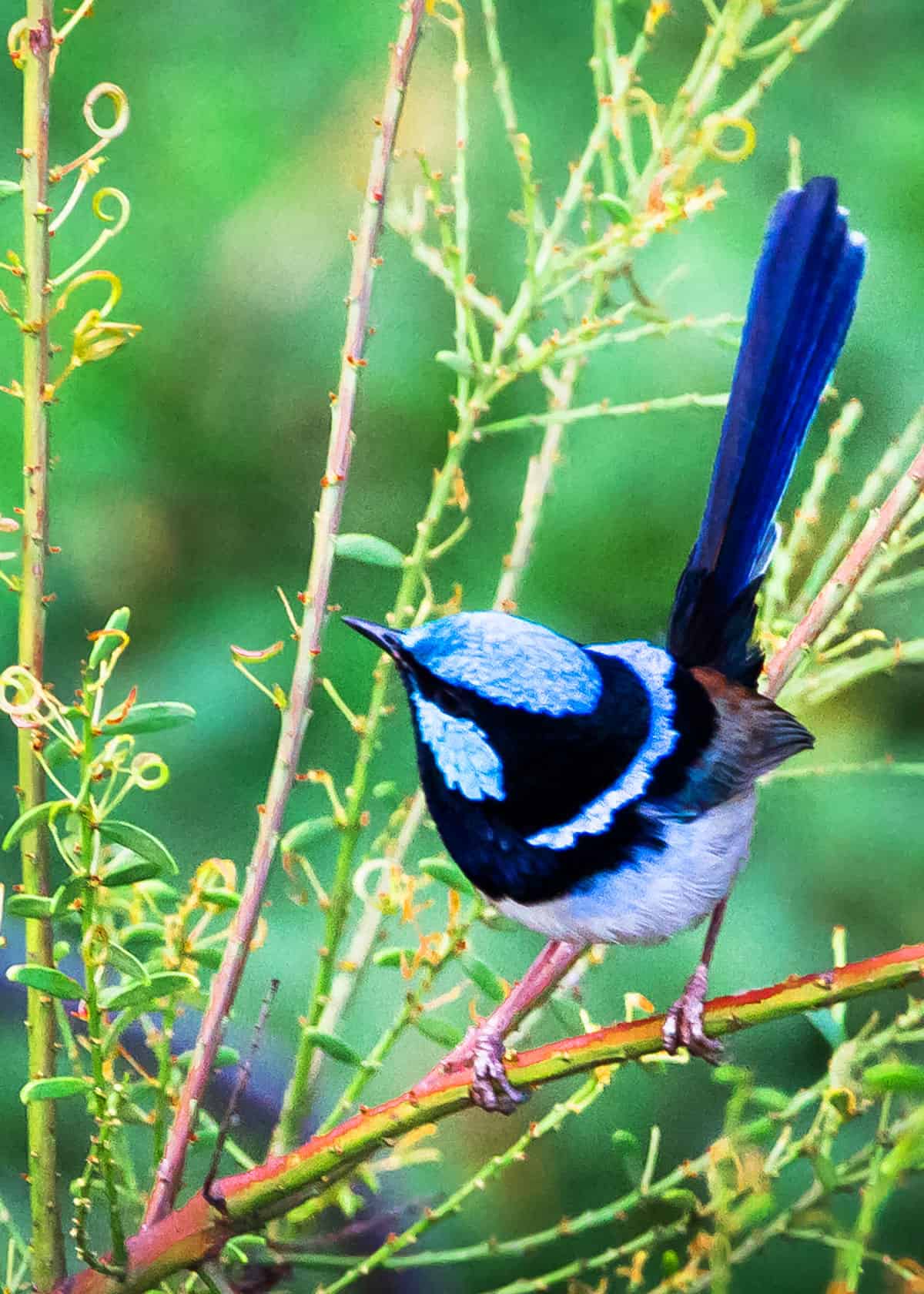
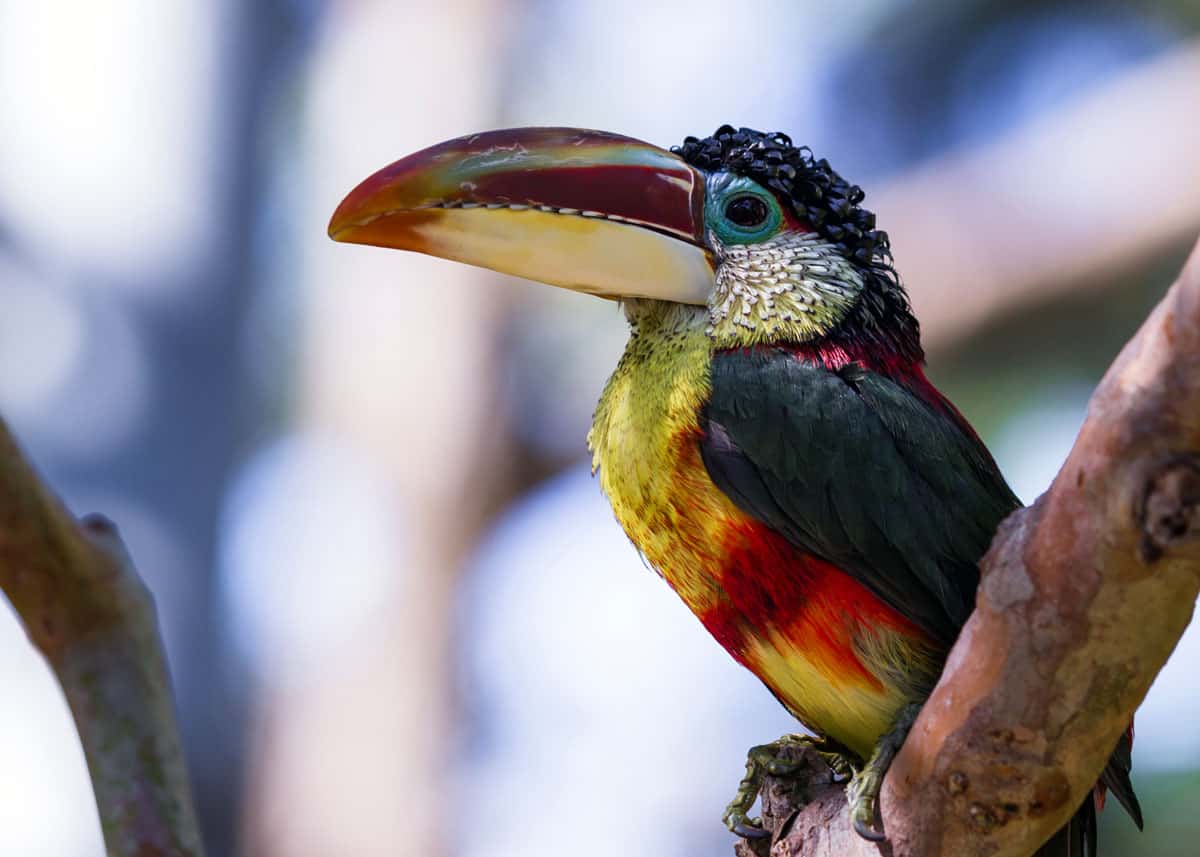
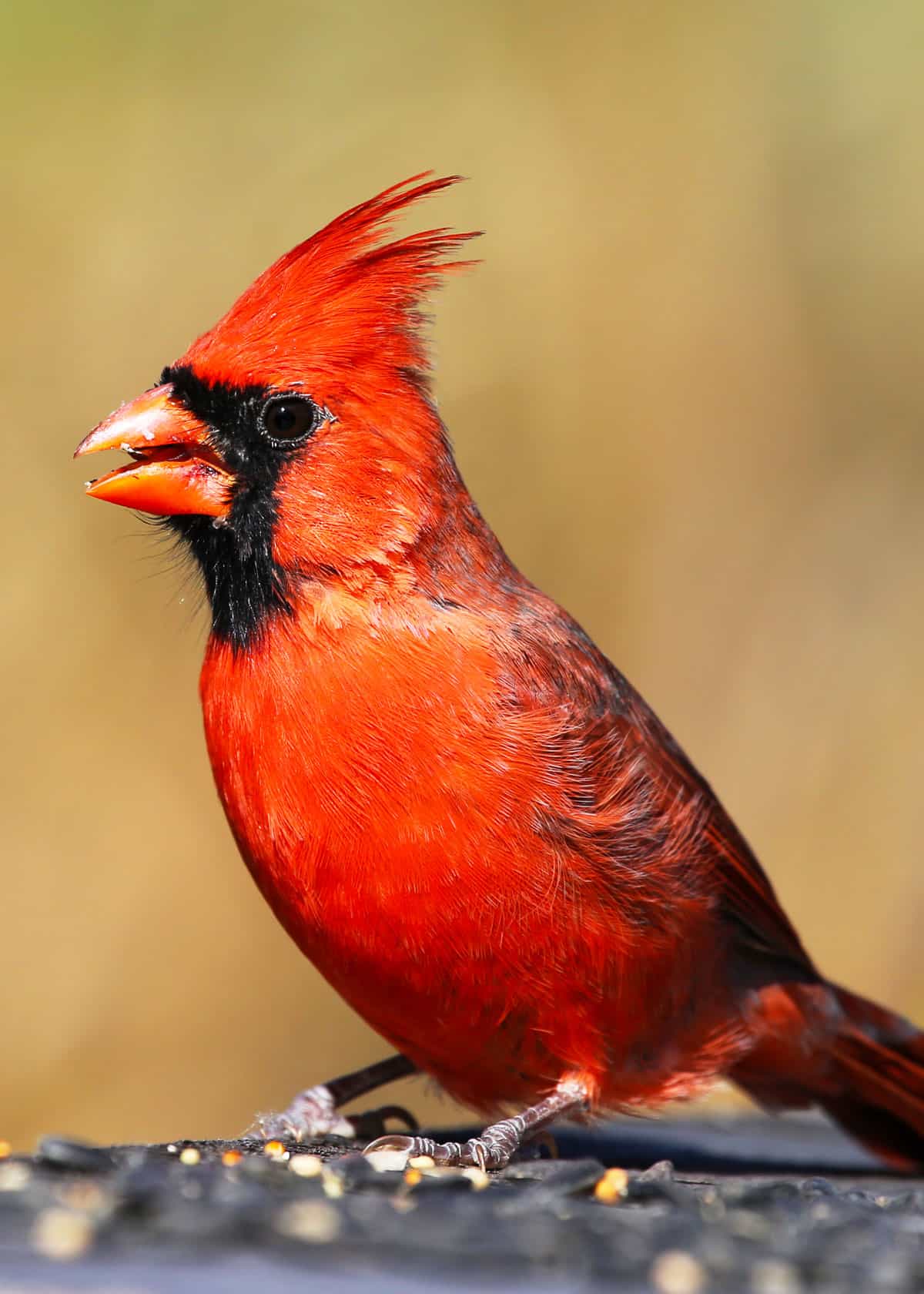
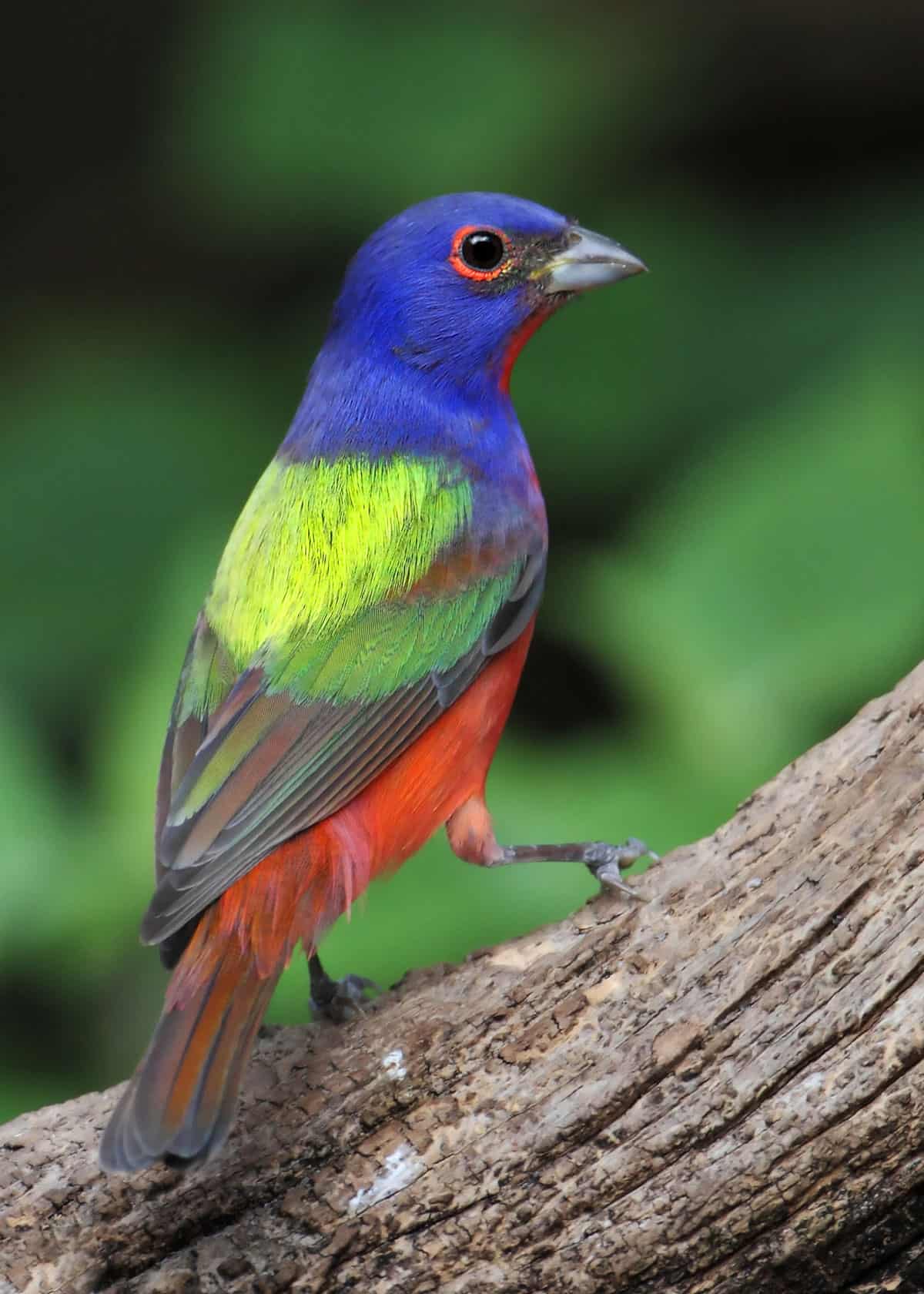
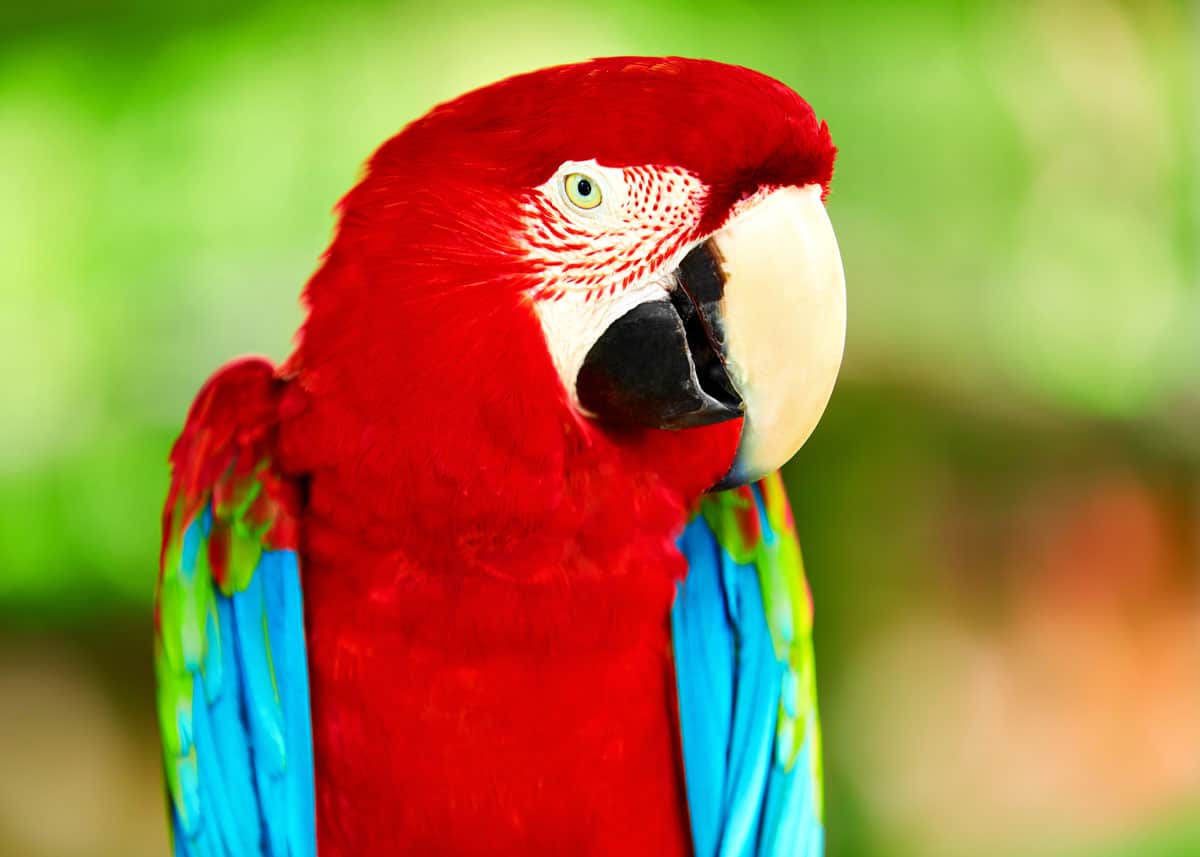
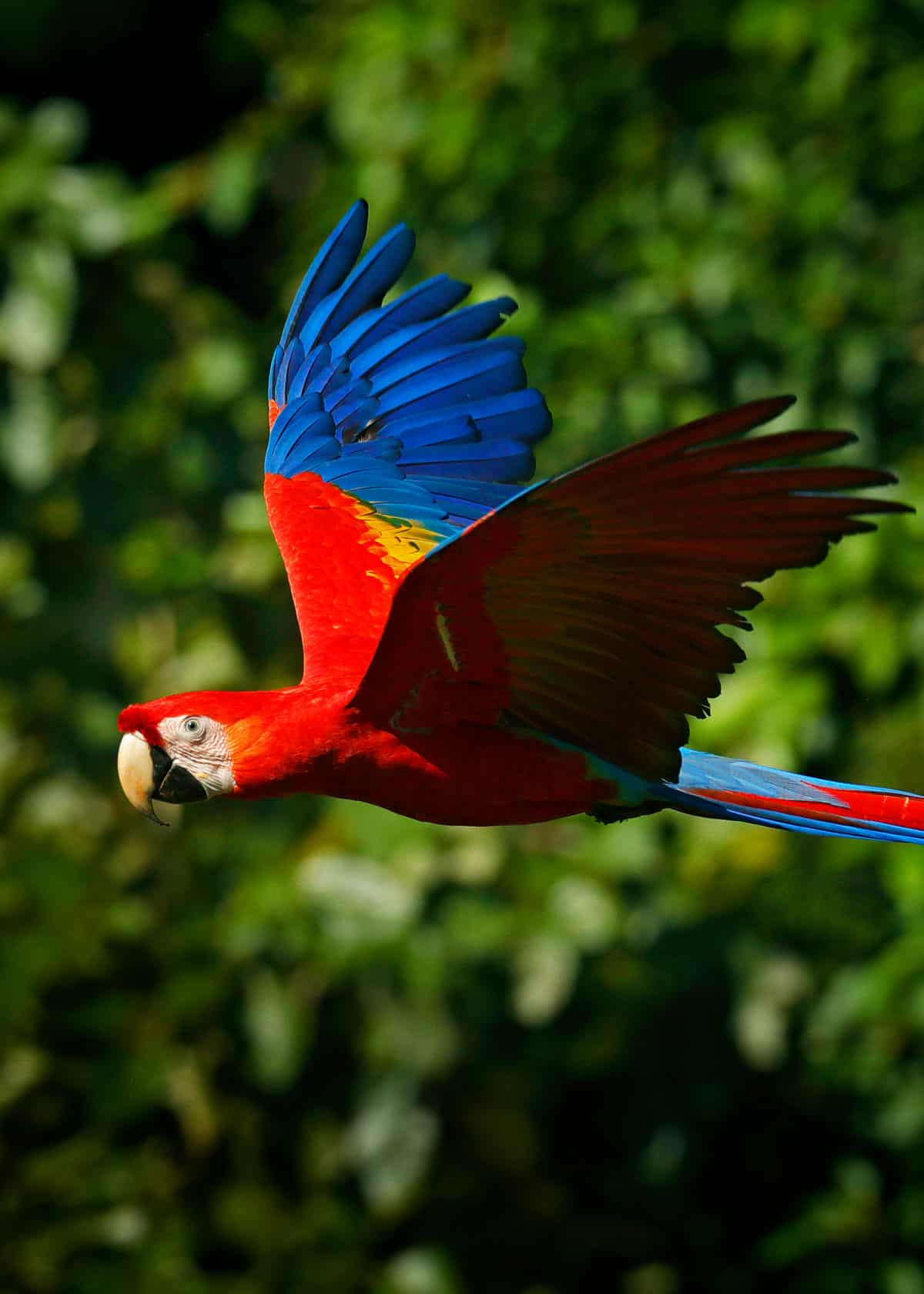

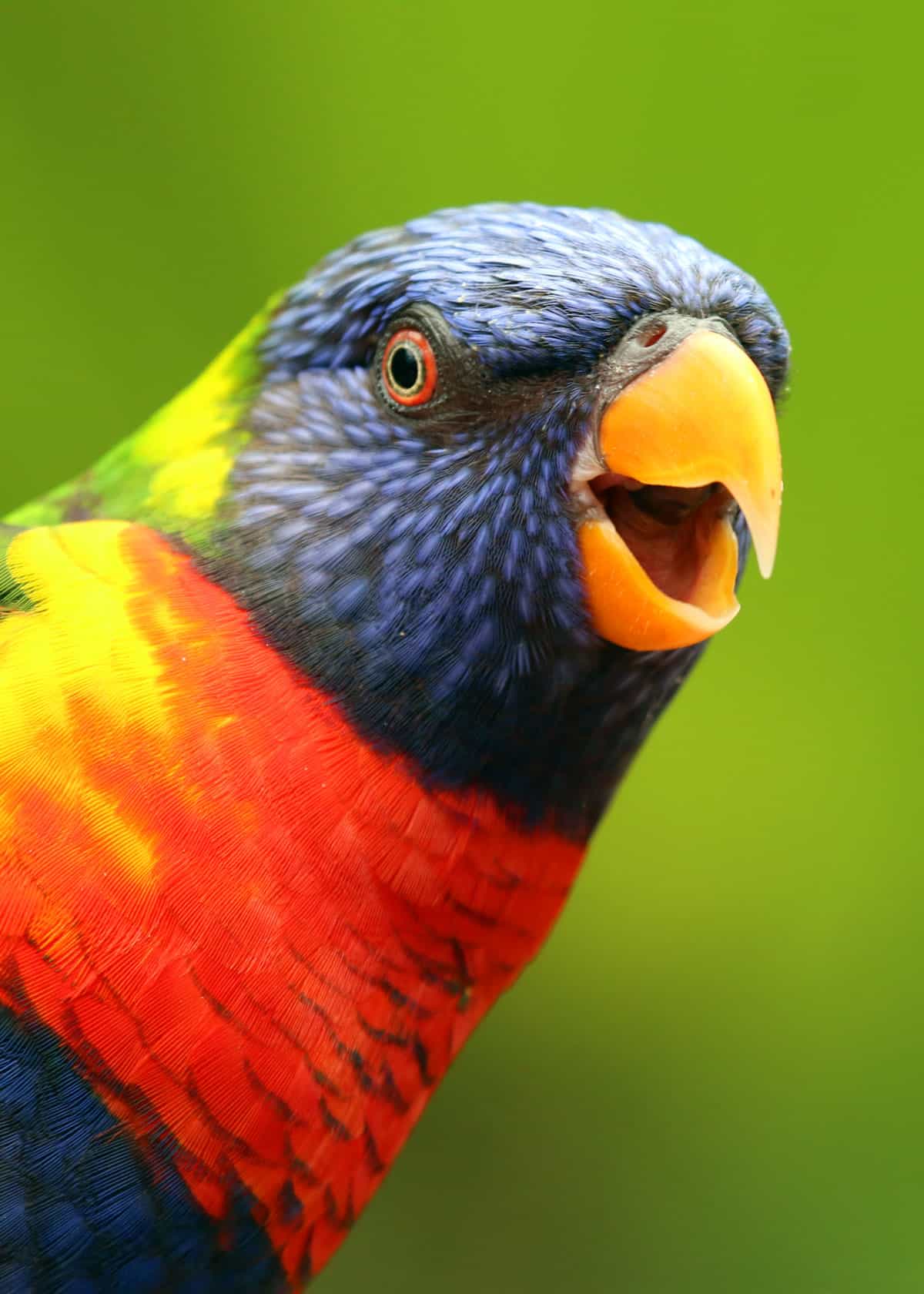
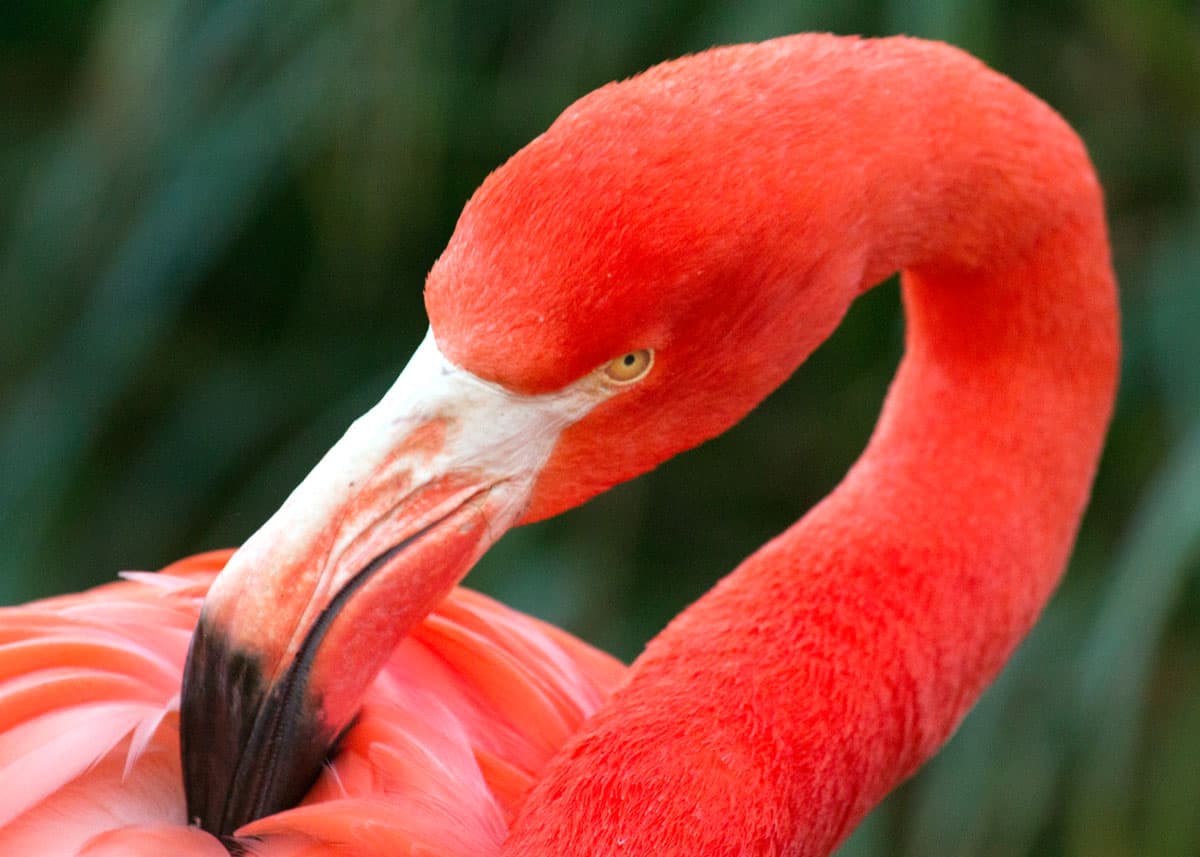
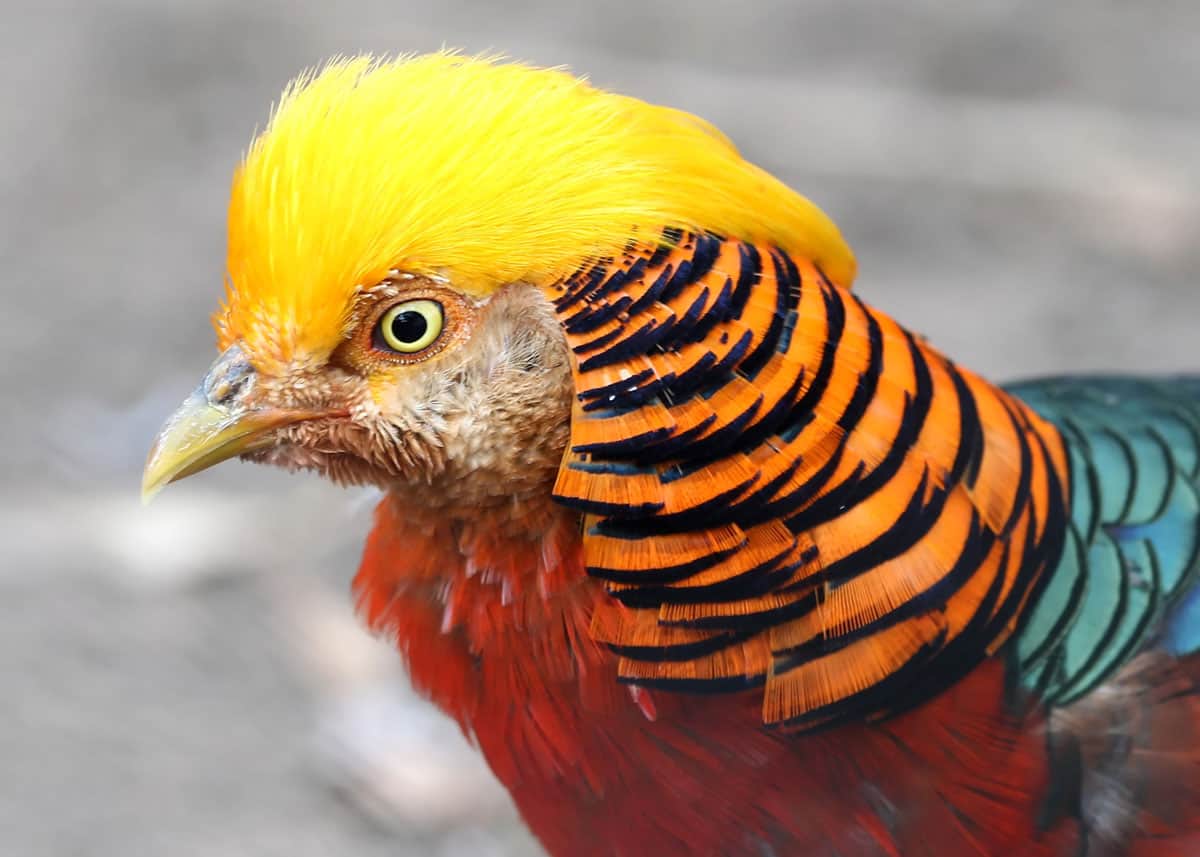

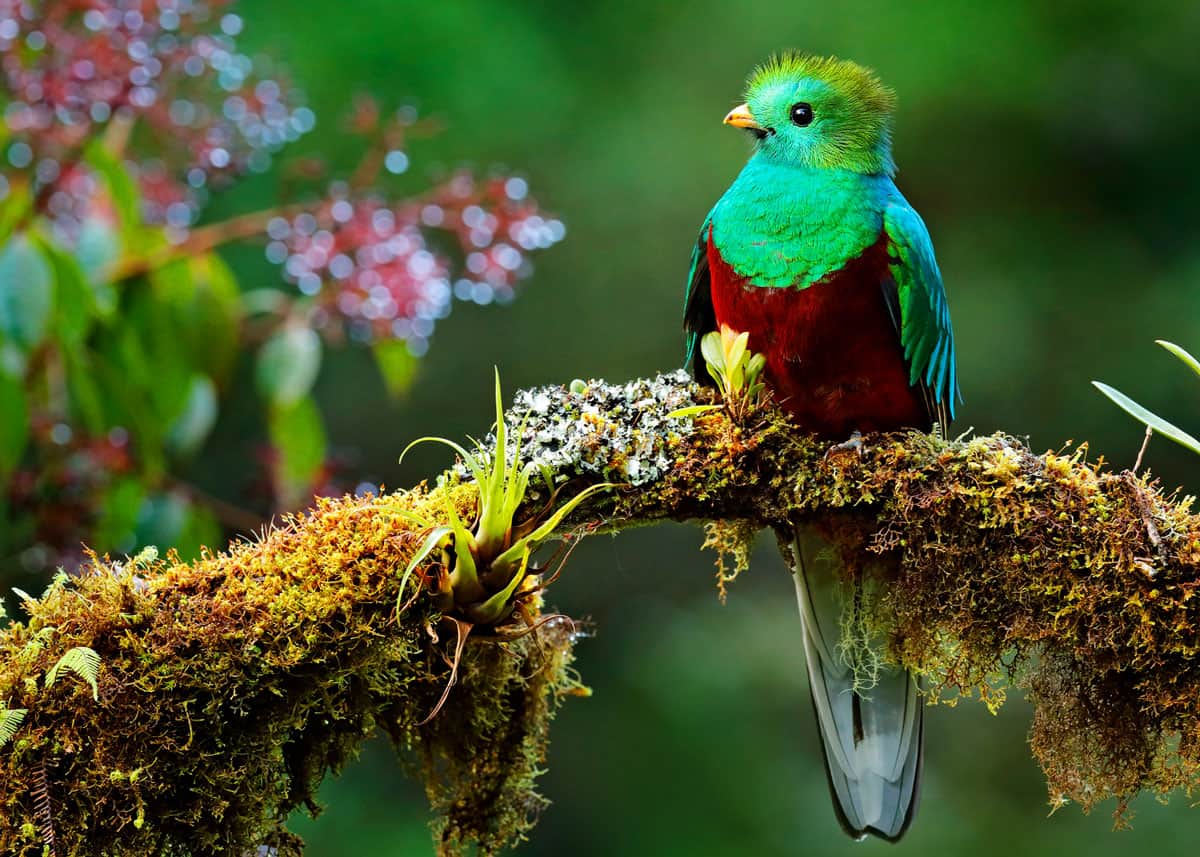
Robert M
Wednesday 3rd of February 2021
How can you leave out the Sun Conure for color?
Jill
Friday 10th of July 2020
I was up in Northern Mn. I passed a body of marshy water that looked like it had a large hot pink and purple bird. There were several white birds Swan size and that is how large that one was. Was I hallucinating?
Shirley Sullivan
Monday 24th of February 2020
Thank you for showing us the wonders and delights of these birds! Truly, God is amazing in the way He pours forth beauty in His creatures.
Liz
Tuesday 24th of December 2019
Hi Drew, I’m writing from South Australia, where we live on the Fleurieu Peninsula. We have Superb Fairy Wrens in our garden, a small flock , maybe 6 to 10 birds it’s hard to know. I wanted to write though and tell you this amazing story though. We have to net our fruit trees or we loose all the fruit to the rosellas and the other fruit eating birds. I tie the nets up so the tree looks like a lollipop to keep the birds from getting trapped under the nets. A few years ago, I found a female Blue Wren, not blue but brown , inside the net on a very large apple tree. I spent most of the day trying to get her out, I cut holes in the net, I loosened the bottom and hitched it up, and I talked to her... a lot! In the evening whilst I was chatting away, she actually flew right up to me and let me catch her in the net. I was amazed as they are very, very quick and very shy. Anyway, I found the scissors (in my pocket luckily) that I’d used to cut the holes in the net and cut her free. Then I stitched up the net and retied the lolly pop affair around the trunk. All done I thought. At that time we used this place as a weekender and when we returned the following weekend and I was watering near the tree, the whole flock of Blue Wrens turned up and hung onto the outside of the net on the same tree...’You little so and sos !’, I said, and warned them not to even think of it! But you know what happened? The female wren left the tree, and the others fell silent.. she flew right up to my face, within an inch or two and fluttered up and down for several seconds. I was completely dumbstruck. Then she and the rest of the flock flew off shrieking into their favourite bushes. I truly was amazed. She knew me, she’d remembered, and she’d let the family know what she was going to do.. they were all there to watch. I feel crazy now relating this story, but I swear it is completely true. I can’t tell one bird from another.. but she knew me. They have never come close like that again. Anyway, I thought the story would amuse you. If you come to Australia.. be in touch🙃🙃
Star VanDyne
Thursday 18th of May 2023
@Liz, I LoVed your story and I DO believe you! Animals are amazing, even the wild ones. I love all the stories of animals who have been rescued by people and remember them later...sometimes years later. It brings me to tears really, how special it is. They detect our pheromones as well as by sight to identify us and "know" us. This is not only about birds and mammals but even sea animals. I had a carpenter bee a few years ago that I swear sought me out. There were hundreds of them but this one bee kept flying up to my face, hovering, staring at me?!? It happened every day. I don't know why. The other bees he lived with in my car port weren't paying any attention to me. Swarms of them all around me which I ignored, but ONE bee thought I was worth checking out. Lovely story, and thank you for your care to rescue the wren. I rescue anything in distress. Nothing is too big or too small. If it's huge, I'll call for help. :-)
scarlet steve
Friday 22nd of November 2019
they are so adorable ,thank you so much for the post, (Resplendent Quetzal) i had never seen such a beautiful bird before.